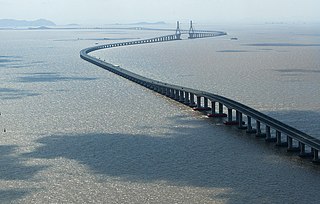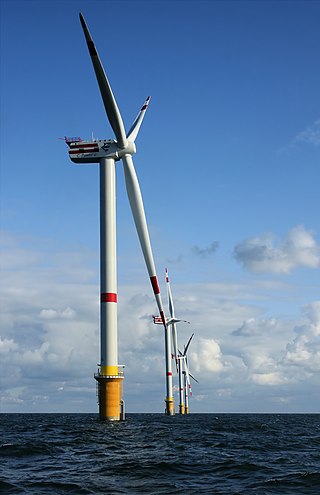
A wind farm or wind park, also called a wind power station or wind power plant, is a group of wind turbines in the same location used to produce electricity. Wind farms vary in size from a small number of turbines to several hundred wind turbines covering an extensive area. Wind farms can be either onshore or offshore.

Donghai Bridge is a Chinese bridge counted among the longest cross-sea bridges in the world. It was completed on December 10, 2005. It has a total length of 32.5 kilometres (20.2 mi) and connects mainland Shanghai's Pudong New Area with the offshore Yangshan Deep-Water Port in Zhejiang's Shengsi County. Most of the bridge is a low-level viaduct. There are also cable-stayed sections to allow for the passage of large ships, the largest with a span of 420 metres (1,380 ft). Donghai Bridge is part of the S2 Hulu Expressway.

The London Array is a 175-turbine 630 MW Round 2 offshore wind farm located 20 kilometres (12 mi) off the Kent coast in the outer Thames Estuary in the United Kingdom. It was the largest offshore wind farm in the world until Walney Extension reached full production in September 2018.

As of 2023, Estonia has a wind power installed capacity of about 376 MW. All operational wind farms in the country are on land. Offshore wind farms are planned on Lake Peipus and in the Baltic Sea near the island of Hiiumaa.

The Thorntonbank Wind Farm is an offshore wind farm, 30 km (19 mi) off the Belgian coast, in water ranging from 12 to 27 metres deep. It is the first offshore wind farm in Belgium.

China is the world leader in wind power generation, with the largest installed capacity of any nation and continued rapid growth in new wind facilities. With its large land mass and long coastline, China has exceptional wind power resources: Wind power remained China's third-largest source of electricity at the end of 2021, accounting for 7.5% of total power generation.

The Burbo Bank Offshore Wind Farm is a 348 MW offshore wind farm located on the Burbo Flats in Liverpool Bay on the west coast of the UK in the Irish Sea. It consists of an original 90 MW wind farm commissioned in 2007 and a 258 MW extension completed in 2017.
Goldwind Science & Technology Co., Ltd., commonly known as Goldwind, is a Chinese multinational wind turbine manufacturer headquartered in Beijing, China. Goldwind was a state-owned enterprise before 2007, with largest shareholders including Hexie Health Insurance, China Three Gorges Renewables Group, and the National Social Security Fund, state-controlled corporations holding almost 40% shares. Its founder, Wu Gang, is a Communist Party member and had a seat in the 12th National People's Congress.

Wind power in Belgium has seen significant advancements, starting with the generation of electricity from offshore wind farms in 2009. By 2020, the capacity of these offshore farms reached 2,262 megawatts (MW), matching the combined output of Belgium's largest nuclear reactors, Doel 4 and Tihange 3. Concurrently, the development of on-shore wind energy, which remained minimal until 2004, experienced significant growth, with installed capacity and production doubling annually from 96 MW in 2004 to 2,476.1 MW by 2021. The percentage of electricity demand met by wind grew to about 14.4% by 2020.

The Ormonde Wind Farm is a wind farm west of Barrow-in-Furness in the Irish Sea. The wind farm covers an area of 8.7 square kilometres (3.4 sq mi). It has a total capacity of 150 MW and is expected to produce around 500 GWh of electricity per year.

The U.S. state of Massachusetts has vast wind energy resources offshore, as well as significant resources onshore. The 2016 update to the states's Clean Energy and Climate Plan had a goal of reducing 1990 baseline greenhouse gas emissions levels by 25% by 2020. Current goals include installing 3,500 megawatts (MW) of offshore wind power in the state by 2035. However, as of Q4 2021 the state had only 120 MW of wind powered electricity generating capacity, responsible for generating 0.9% of in-state electricity production. The state has awarded contracts to two offshore projects, the 800 MW Vineyard Wind project and 804 MW Mayflower Wind project. Construction began on the Vineyard Wind 1 project on November 18, 2021, after a long fight for approval. Commonwealth Wind was selected for development in 2021, but the developer has attempted to cancel the project due to increased costs. There are eight projects planned for off the southern coast of Massachusetts, though some will deliver power to Rhode Island, Connecticut, and New York.

Nordsee-Ost offshore wind farm is an offshore wind farm in operation in the eastern part of the North Sea German sector. The project was developed by RWE Innogy, a subsidiary of RWE.
Race Bank Wind Farm is a 573 MW Round 2 offshore wind farm located 27 km north of Blakeney Point off the coast of Norfolk, and 28 km east of Chapel St Leonards off the Lincolnshire coast in the North Sea. The farm was commissioned in February 2018.

Sinovel Wind Group Company is a Chinese state-owned wind turbine manufacturer headquartered in Beijing.

Veja Mate is a German 402 MW offshore wind farm in the German Bight of the North Sea about 95 km northwest of Borkum. The wind farm consists of 67 Siemens Wind Power SWT-6.0-154 turbines, each with a 6 MW capacity.

The Guishan Offshore Windfarm is a 198MW offshore wind farm near Zhuhai in Guangdong province, China.














